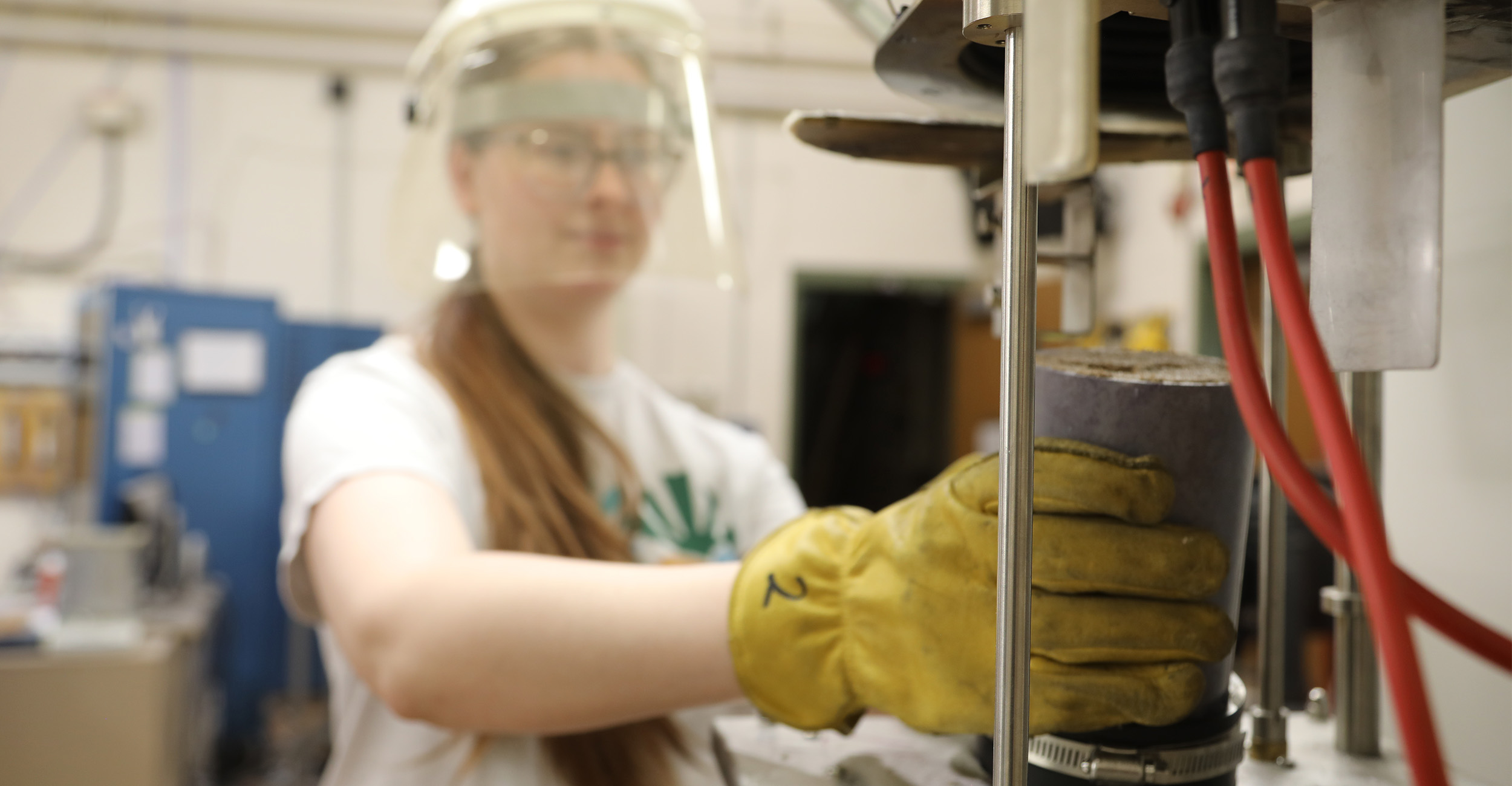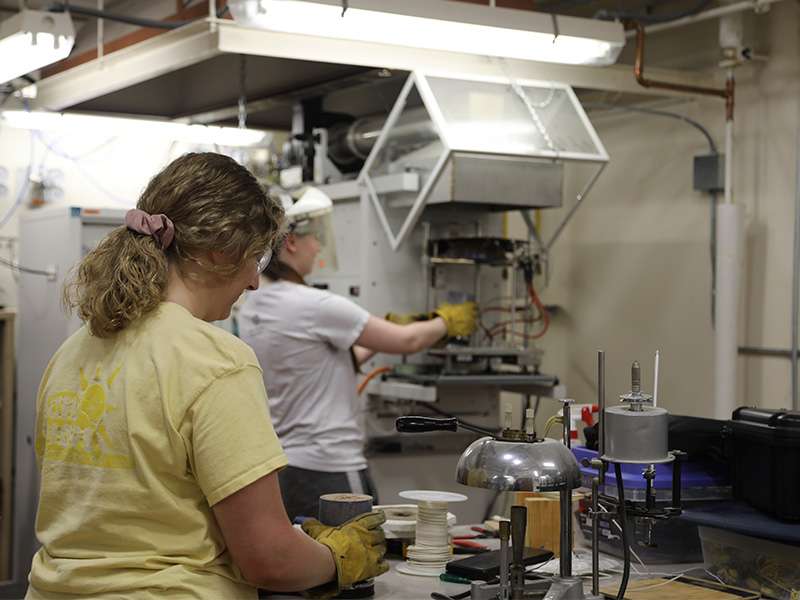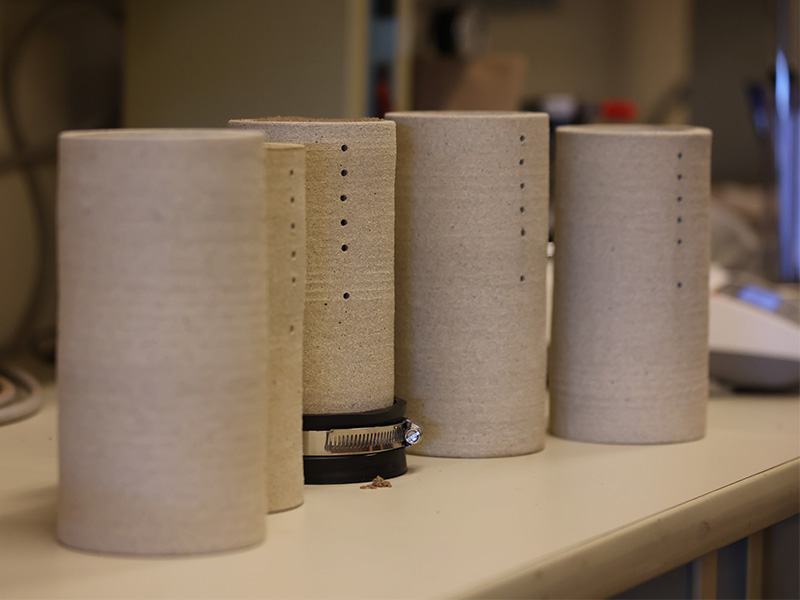
Earth Water & Fire: The science behind post-wildfire soil behavior
Wednesday, October 30, 2024
Media Contact: Kristi Wheeler | Manager, CEAT Marketing and Communications | 405-744-5831 | kristi.wheeler@okstate.edu
When wildfires spread, nothing stands a chance in their path.
The devastation left above ground is evident after a fire burns through an area, but what about below ground?
That is what Dr. Jaime Schussler of Oklahoma State University’s School of Civil and Environmental Engineering is working with undergraduate students from the University of Central Oklahoma and OSU to find out.
Their research evaluates wildfires’ impacts on soil characteristics and the subsequent consequences.
While the undergraduate researchers receive primary advisement from Schussler, they collaborate and conduct laboratory work with Dr. Haejun Park of Fire Protection and Safety Engineering.
This undergraduate research opportunity started with a mentorship that Schussler and Dr. Mary Foltz led in the spring semester of 2024, funded by Oklahoma NSF EPSCoR. The two created a statewide mentorship program around water research — a broad topic that many students and researchers could connect with.
This mentorship program created trios comprised of a faculty member familiar with water research, a graduate student from OSU and an undergraduate student from an Oklahoma college or university.

At the end of the mentorship program, Schussler garnered funding from the Oklahoma State Regents for Higher Education for Research Experiences for Undergraduates to continue the momentum.
The two students taking part in this REU are Aria Hansen, a UCO environmental chemistry
student who was Schussler’s mentee, and Jordan Erne, an OSU civil and environmental
engineering student who first connected with Schussler in their hydrology course.
“It’s been a beautiful, rewarding experience for all involved,” Schussler said. “The
UCO student has been able to experience the labs and facilities an R1 like OSU offers,
which helps contextualize the type of research that is possible. Jordan has been able
to peer-mentor and show her around campus — inside and out of research. The shared
experience provides early exposure to collaborative, interdisciplinary research and
has made the process less intimidating for these students who are experiencing it
for the first time.”
Schussler notes that the trio mentorship program builds a sense of accountability for the students while giving them the confidence to ask the right questions and be more exploratory.
“I love watching them work together and empower each other — they work well as a team,” Schussler said.
The students are looking at the effects of compounding events, specifically the interface
between wildfires and floods.
After a fire, several environmental changes take place, especially within the soil.
One phenomenon that often takes place is hydrophobicity. This is where the soil will
repel water.
Some research shows that the hydrophobic layer results from a waxy substance derived
from burned organic material.
Another less investigated occurrence that can happen with a wildfire is the creation
of a “crust” on the topmost soil layer. When fire interfaces with the land, vegetation
and soil moisture are rapidly lost from top horizon. The magnitude of this effect
is mainly dependent on the soil type.
Schussler likened this event to clay forming pottery. As the available soil moisture is removed from the soil pore space, the soil becomes dry, hard and compact. Vegetation is no longer present to capture, or uptake moisture and the root pathways may be blocked or diminished.
When a rainfall event comes shortly after a fire event, the stormwater cannot move through the resulting crust and penetrates the soil much slower than in pre-burn conditions.
“After a fire, you start to see some crusting on open soils,” Schussler said. “Then, when the rainfall comes in, it actually can’t go through or infiltrate through that soil.”
The same thing can happen after a prolonged drought. When much-needed rainfall arrives after an intense burn or drought, the water might not be able to infiltrate the soil at the normal rate. This can increase runoff rates, compounding further issues like erosion and debris flows.
“Once the sediment and debris reach our conveyance or surface water systems, we have to further deal with repercussions like reduced conveyance capacities and water quality impairments, such as turbidity,” Schussler said.
Turbidity is when fine soil particles become suspended in the water column, creating darker, murky water that can cause significant issues for aquatic ecosystems and recreation.
The research primarily investigates the crusting effect to estimate hydraulic conductivity rates or how fast water can move through the soil after burning. Hydrophobicity is also being considered. The research intends to update parameters used in hydrological models to better estimate flood extent after wildfire.
Currently, there is a lack of scientifically backed data to modify the hydraulic conductivity values of soil after a fire happens. This means that when modeling the areas impacted by fire, there is often no distinction, making model calibration and accuracy challenging.
Schussler and the undergraduate students are conducting experimental work with Park
to see exactly how the soil is changed, how it affects hydraulic conductivity and
how to implement that into hydrological models.
To gather this data, soil samples are placed in cylinders and then placed within a
cone heater that simulates wildfire under varying intensities.
Then, column studies are conducted to compare how water moves through the burned soil versus the control sample. In total, they are considering the 12 soil groups included on the soil texture triangle.

One issue the students ran into was the type of cylinder to use. In the cone heater,
the plastic cylinders with protected tops would still melt. Metal cylinders could
not be used due to the conductive properties affecting deeper soil layers, leading
to skewed data.
The students reached out to Prairie Arts Center and worked with them to outsource
ceramic cylinders from local artists, making this project even more collaborative.
“These are the sort of projects that get undergrads involved,” Schussler said. “They are visual and very tangible for them. It helps develop some of that confidence and excitement for research.”
The project has hopes to continue later into the year and extend to include the expertise of Park and Dr. Chen Chen. Schussler has a hydrology background, Park has fire simulation techniques and Chen will bring his emergency management and planning knowledge. With such a collaborative effort, the team would be able to collect a significant amount of preliminary data and work toward a bigger proposal.
The research from that project could help predict the impact of a fire-flood compound event — resulting in better emergency management planning and distribution of appropriate resources.
Future plans include adding different fuel sources on top of the soil samples, such as different grasses or leaves, to see the impact, as well as rainfall simulations to test the response of the burned soils under varying rainfall intensity and frequency.
Teaching undergraduates is a role that Schussler sees as a great responsibility. She said she enjoys sharing a passion for water resources work with her graduate students.
“I get so pumped up and excited when an undergraduate comes to me, and they’ve never been exposed to water resources!” Schussler said. “A lot of times, I am their first experience when it comes to water resources engineering and their first exposure to research. I take that as a huge responsibility, but also, a really cool opportunity.”
Schussler notes that students will often gravitate toward water resources engineering once they learn of it because it is something that affects everyone daily.
“Everybody experiences rainfall at some point and can picture a storm drain, often in the neighborhood they grew up in,” she said. “And a lot of us have lived through the impact of a situation where there is too much or too little water, or poor water quality. I get to provide students the tools and empower them to solve these very real challenges.”
Growing up in a small town of about 2,000 people, Schussler experienced several boil advisories for water quality and missed school because of an industrial chemical spill that affected the local drinking water supply.
Seeing instances like these and how they affected the environment and people’s recreational use of water led Schussler to a career in civil and environmental engineering.
As a first-generation college student, she participated in an exchange program that provided her first undergraduate research exposure in France. Schussler was taught various water quality assessment techniques by a Ph.D. student who was monitoring waterbodies under the European Water Framework Directive.
Schussler quickly realized she enjoyed the research process and the people she was surrounded with. Her graduate advisor explained that graduate school would provide her with a similar experience — to be around people of all backgrounds and assured her she’d keep getting her toes wet and hands dirty.
It’s still her favorite part of research today.
Photos by: Desa James
Story by: Desa James | IMPACT Magazine
